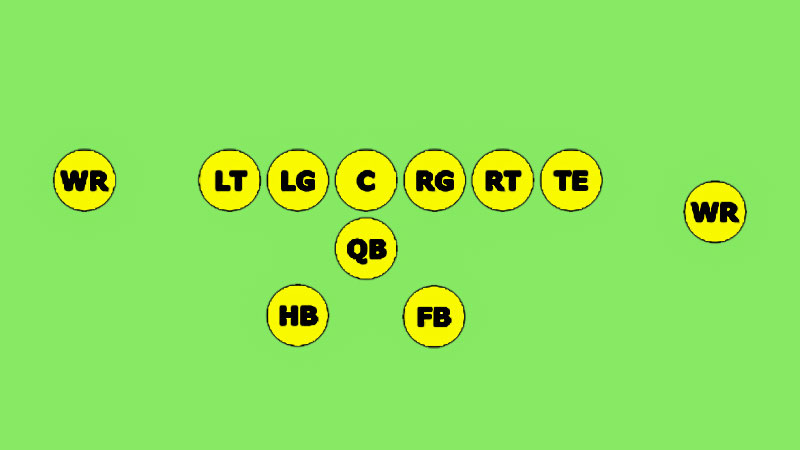In the dynamic world of American football, formations play a crucial role in strategizing and executing plays. One such formation, the pro set, has been a staple for both professional and amateur teams.
Unlike the traditional I-formation, the pro set features two running backs aligned side by side, offering a versatile approach to both running and passing plays.
The pro set formation evolved from the three running back T-formation, with one halfback becoming a permanent wide receiver. This shift not only diversified offensive strategies but also created favorable matchups by removing a defensive player from the tackle box.
With variations like the Pro Ace and Tree, the pro set provides a flexible offensive framework that can adapt to different defensive setups, making it a valuable asset in any team’s playbook.
Explained: Pro Set Formation in American Football
The pro set formation in football, also known as the split backs formation, offers a balanced and adaptable approach to offensive plays.
Basics of the Pro Set Formation
The pro set formation features two running backs aligned side by side, approximately 5 yards behind the quarterback. This setup allows for numerous offensive strategies, such as lead runs, misdirection runs, and play-action passes.
The versatility of the pro set makes it a valuable asset for keeping defenses guessing and creating favorable matchups. Key positions include the quarterback (QB), two running backs (RB), tight end (TE), and two wide receivers (WR).
Evolution and History
The pro set formation evolved from the T-formation, adapting to modern football’s need for more versatile and dynamic offensive strategies. First popularized in the mid-20th century, it gained prominence for its ability to balance the running and passing game effectively.
Coaches like Harold “Tubby” Raymond at the University of Delaware used it to great success, winning three national championships. This evolution allowed teams to remove a defensive player from the tackle box, creating more opportunities for successful plays.
Characteristics of the Pro Set Formation
The pro set formation, also known as the split backs formation, is a cornerstone of American football offense. It combines versatility and balance, allowing for diverse strategic plays.
Offensive Strengths
The pro set formation offers several offensive strengths:
- Versatility: The alignment of two running backs side by side allows for various play types, including lead runs, misdirection runs, and play-action passes.
- Balanced Attack: With a tight end and two wide receivers, this formation achieves a balanced attack, enabling both strong running and effective passing plays.
- Flexibility in Play Calling: This formation permits the quarterback to make adjustments based on defensive setups, increasing the offensive unit’s adaptability during the game.
- Matchup Advantages: Spreading the offense removes a defensive player from the tackle box, creating favorable one-on-one matchups for running backs and receivers.
Offensive Considerations
When considering the offensive aspects of the pro set formation in American football, several key considerations arise:
- Predictability: Defenses familiar with the pro set’s versatility might anticipate the play type, reducing the element of surprise.
- Protection Concerns: With only five offensive linemen and occasional tight end assistance, protecting the quarterback during deep passes can be challenging.
- Limited Downfield Threats: Depending on running backs for blocking and short passes might limit the frequency of deep passes, making the offense less explosive at times.
- Running Game Durability: Overreliance on the running game due to dual running backs can result in wear and tear on primary ball carriers over the course of a season.
Key Positions and Roles in the Pro Set Formation
The pro set formation relies on well-defined roles to maximize its strategic advantages. Understanding these key positions helps illustrate its effectiveness in American football.
Role of the Quarterback
The quarterback in the pro set formation directs the offense and ensures the execution of plays. Positioned under center, he initiates the snap and assesses the defense. The quarterback’s responsibilities include:
- Play Execution: Carrying out handoffs to running backs or performing play-action passes.
- Defense Reading: Identifying defensive alignments to make pre-snap adjustments.
- Passing Precision: Delivering accurate throws to wide receivers, tight ends, or running backs.
Responsibilities of the Running Backs
With two running backs in the backfield, the pro set formation leverages their skills for both running plays and blocking assignments. Their responsibilities include:
Offensive Responsibilities
The offensive responsibilities of running backs in the pro set formation include lead blocking, receiving passes, and providing crucial pass protection for the quarterback.
- Lead Blocking: Creating paths for the other running back or quarterback during running plays.
- Receiving Duties: Catching passes out of the backfield to add versatility to the offense.
- Pass Protection: Assisting the offensive line in protecting the quarterback during passing plays.
Defensive Responsibilities
Defensive Responsibilities of the Running Backs entail blocking, receiving, and adjusting to defensive shifts, crucial for protecting the quarterback and executing offensive plays effectively.
- Run Blocking: Opening gaps for running backs to exploit during rushing attempts.
- Pass Protection: Forming a pocket to give the quarterback time for passing.
- Adjustments: Communicating and adjusting to defensive shifts and blitzes.
Popular Plays in the Pro Set Formation
Teams leverage the pro set formation for its versatility in both running and passing plays. This section delves into some of the common running and passing strategies employed within this formation.
Typical Running Plays
Running plays in the pro set formation capitalize on its balanced backfield and versatile offensive line. Here are some common strategies:
Lead Runs
The offense uses lead runs to exploit gaps in the defense. With two running backs aligned side-by-side, one can act as a lead blocker while the other carries the ball. This play usually targets the interior gaps of the defensive line, forcing defenders to react quickly.
Counter Runs
Counter runs mislead the defense’s initial read. One running back initially moves in one direction, while the other back takes the handoff and runs opposite. This execution forces defenders out of position, creating running lanes.
Sweep Runs
Sweep runs extend the play horizontally. The running back receives the ball and runs parallel to the line of scrimmage to find a running lane. Offensive linemen and the other running back provide crucial blocks to seal off defenders and create open space on the outside.
Draw Plays
In draw plays, the quarterback fakes a pass to draw defenders into coverage, then hands the ball to a running back. This strategy exploits defenses expecting a pass and can result in significant yardage if the run lanes are open.
Common Passing Strategies
Passing plays in the pro set formation leverage its balanced alignment and multiple receiving options. Here are some typical strategies:
Play-Action Passes
Play-action passes leverage the threat of a run to deceive defenders. The quarterback fakes a handoff to the running back, pulling linebackers and safeties towards the line of scrimmage, and then throws the ball downfield. This strategy creates opportunities for big gains through the air.
Short Passes
Short passes, like slants and quick outs, take advantage of the balanced formation. With two running backs and multiple receiving options, the quarterback can quickly release the ball to avoid pressure. These passes keep defenses off-balance while gaining steady yardage.
Screen Passes
Screen passes involve the quarterback quickly passing to a running back after allowing the defensive line to advance. Offensive linemen then move to block downfield, setting up a wall for the running back.
This play neutralizes aggressive pass rushes and opens avenues for significant gains.
Deep Routes
When defenses crowd the line of scrimmage, deep routes become effective. Running backs and wide receivers run vertical routes to stretch the defense, providing the quarterback opportunities for big gains.
The threat of a balanced offense in the pro set makes these deep passes unpredictable and crucial for explosive plays.
Adaptations and Variations
The pro set formation has evolved significantly, adapting to modern football strategies while retaining its foundational balance and versatility.
Modern Adaptations in Pro Formation
Modern adaptations of the pro set include adjustments to personnel and positioning based on defensive schemes. Coaches often replace one tight end with an additional wide receiver to exploit defensive mismatches.
Teams also incorporate hybrid players, like tight ends who can function as wide receivers or fullbacks who can serve as both blockers and ball carriers. These adaptations enhance the formation’s flexibility, making it suitable for various offensive strategies.
Comparisons with Other Formations
When comparing the pro set to other formations like the spread or shotgun, the pro set offers a balanced attack with strong running and passing options.
Unlike the spread formation, which focuses on wide receiver-heavy play to stretch the field horizontally, the pro set uses tight ends and a balanced line for inside runs and short-to-intermediate passes.
Compared to the shotgun, where the quarterback receives the snap several yards behind the line to emphasize passing, the pro set allows for quick handoffs and traditional drop-back passes, providing a multi-dimensional offensive approach.
Frequently Asked Questions
What is the pro set formation in American football?
The pro set formation is an offensive setup that features a balanced alignment with both a fullback and a halfback positioned in a split formation parallel to the line of scrimmage. This setup allows for versatile offensive plays, including inside runs, short passes, and traditional drop-back passes.
How has the pro set formation evolved over time?
The pro set originated from the T-formation and evolved to include modern adaptations based on defensive schemes. These adaptations involve adjustments in personnel, such as employing hybrid players and flexible positioning to enhance the overall offensive strategy while maintaining balance and versatility.
What are the strategic advantages of the pro set formation?
The pro set formation offers strategic advantages like creating favorable matchups against the defense and enabling varied offensive approaches. It facilitates quick handoffs, inside runs, short-intermediate passes, and traditional drop-back passes, making it a multi-dimensional offensive strategy.
How does the pro set formation compare to the shotgun and spread formations?
While the shotgun and spread formations focus on spreading the field and often employ a pass-heavy approach, the pro set stands out for its balanced attack. It utilizes tight ends for more efficient inside runs and short passes, ensuring a more diversified and unpredictable offensive strategy.
What roles do key positions play in the pro set formation?
In the pro set formation, the fullback and halfback are crucial for executing inside runs and quick handoffs. Tight ends play a significant role in short to intermediate passing routes and blocking. These positions work in tandem to exploit defensive weaknesses and maintain offensive balance.
Conclusion
The pro set formation remains a cornerstone in American football due to its adaptability and strategic depth. Teams leveraging this formation can exploit defensive weaknesses with a balanced attack, blending traditional and modern offensive tactics.
By incorporating hybrid players and adjusting to defensive schemes, the pro set continues to be relevant in today’s game. Its ability to facilitate varied offensive plays makes it a valuable tool for any team aiming to maintain unpredictability and control on the field.
Coaches often favor the pro set for its versatility, allowing quick transitions between run and pass plays. This formation’s flexibility aids in exploiting mismatches and creating opportunities for big gains.
Additionally, the alignment of the pro set can confuse defenses, making it harder for them to anticipate the play. As a result, teams often use pre-snap motions to further bewilder opponents, enhancing their tactical edge.








Ashley Hopkinson